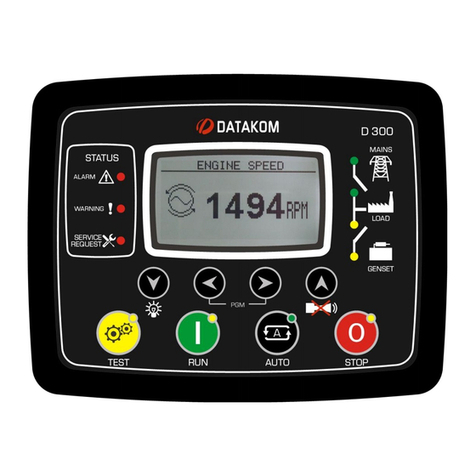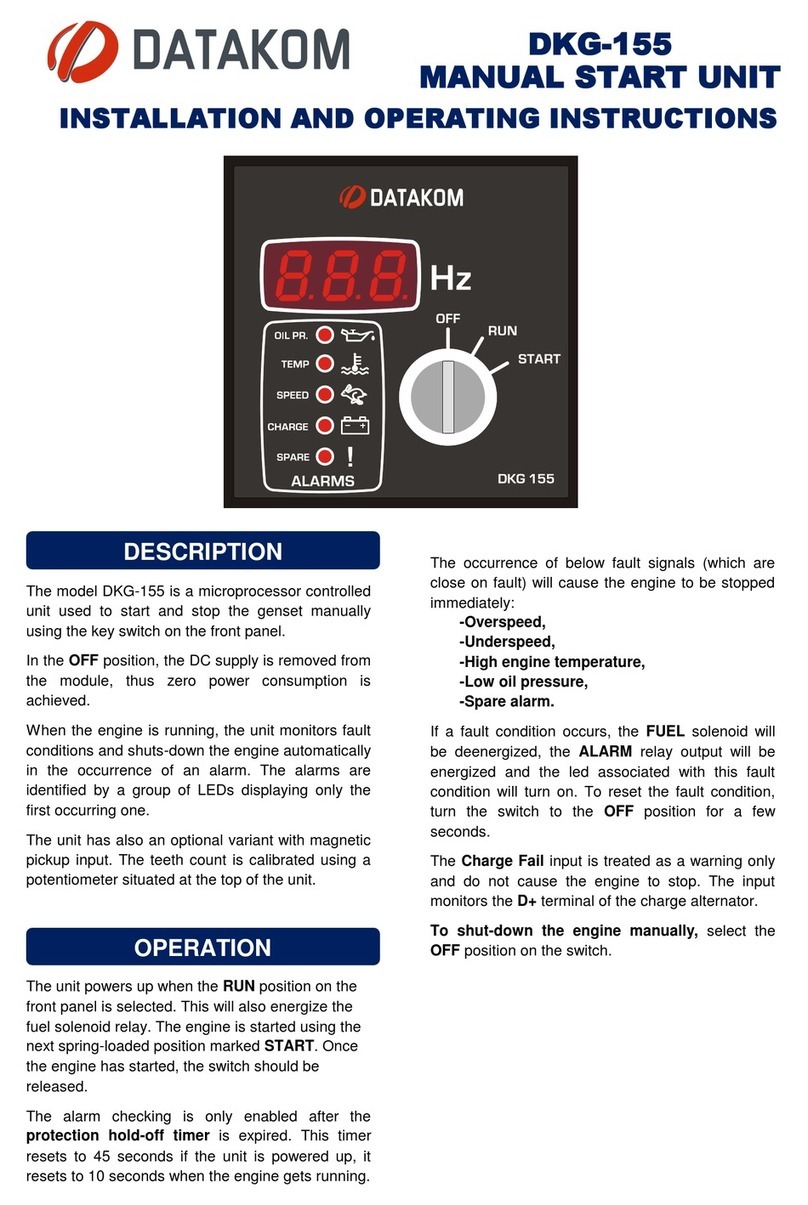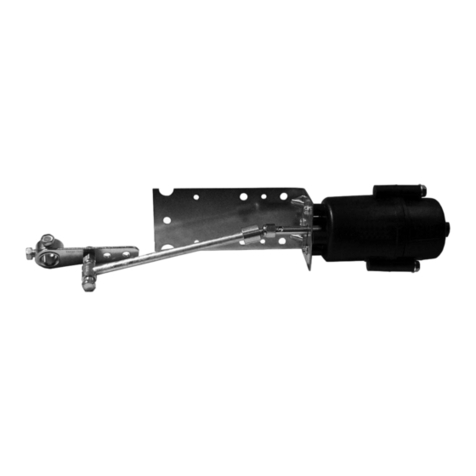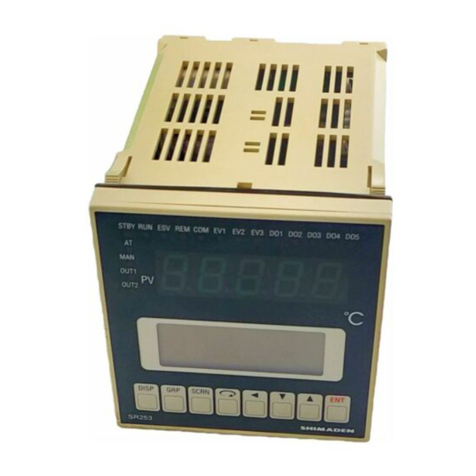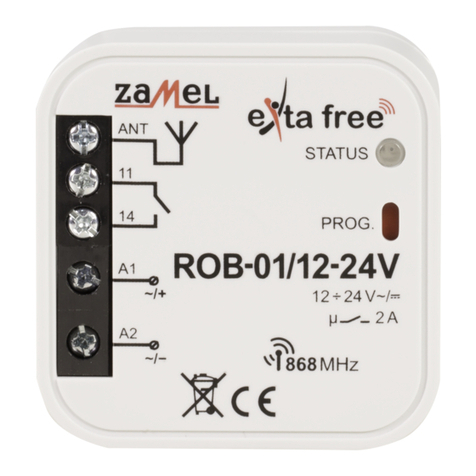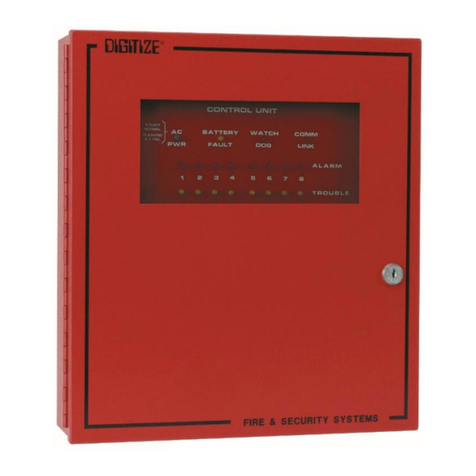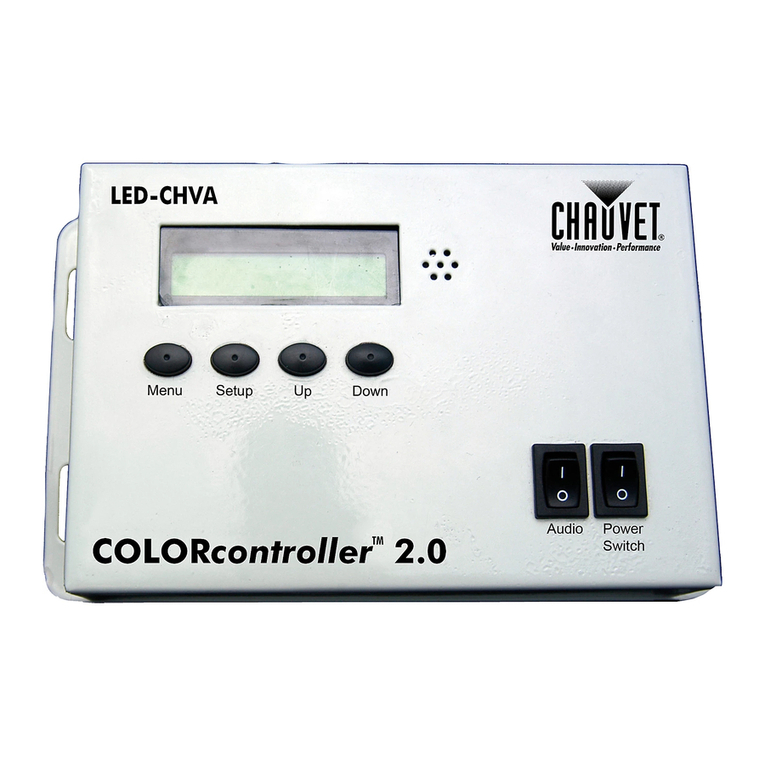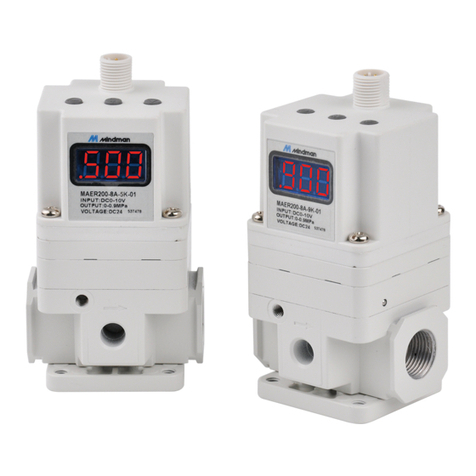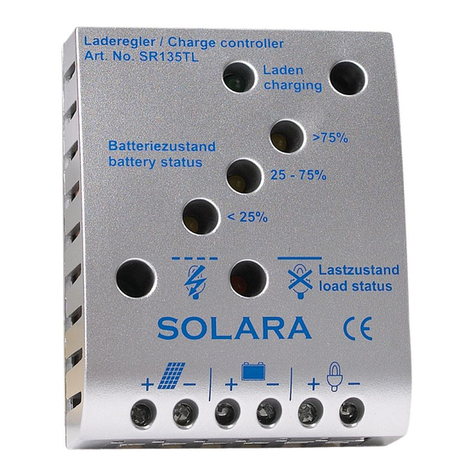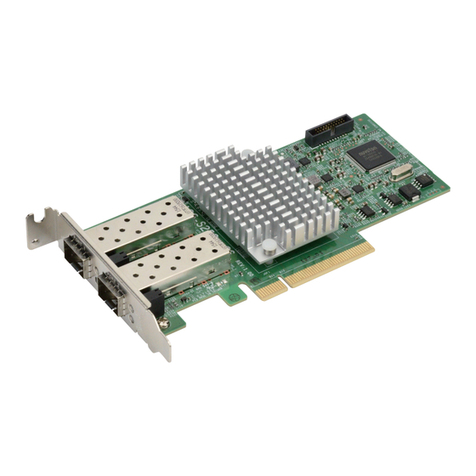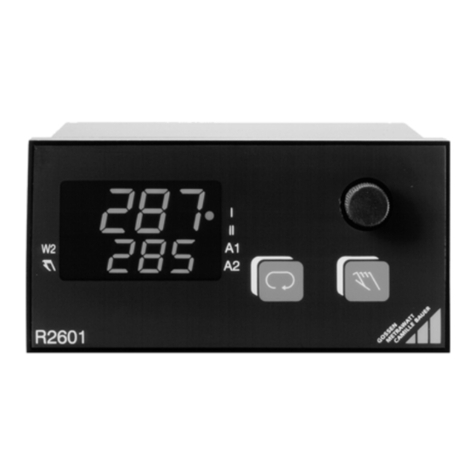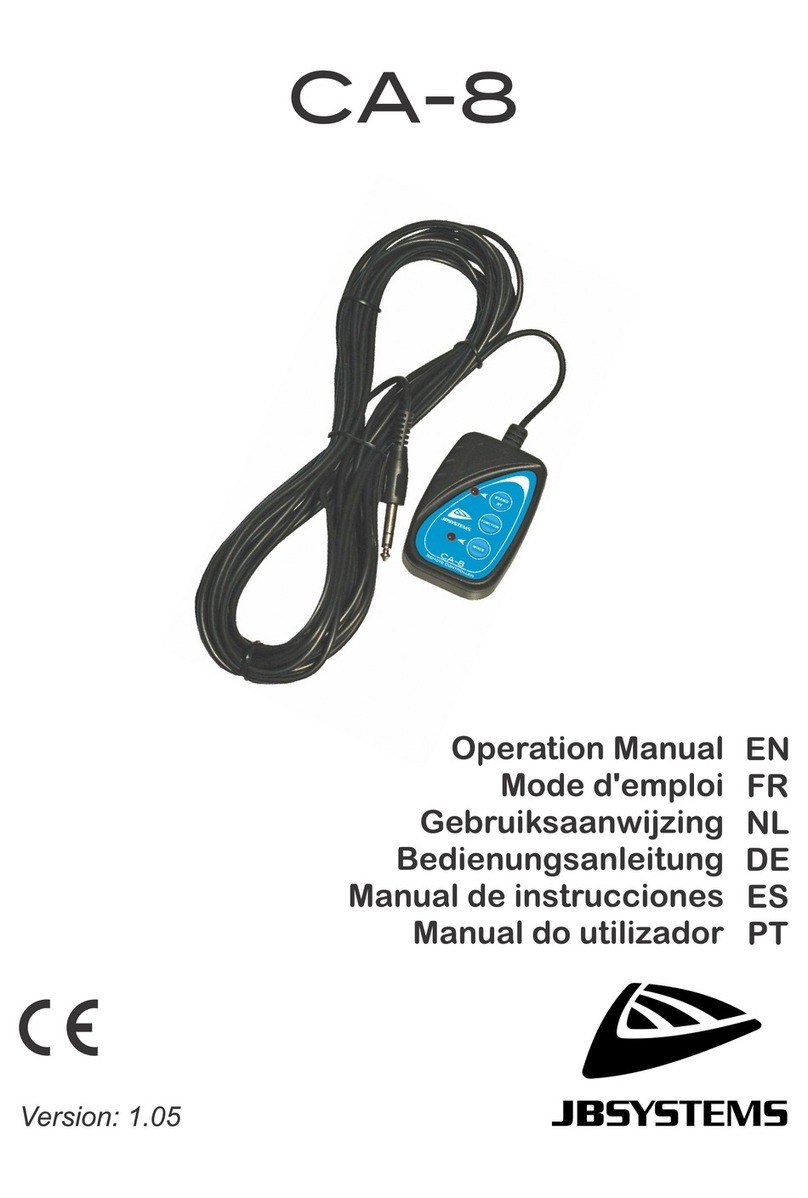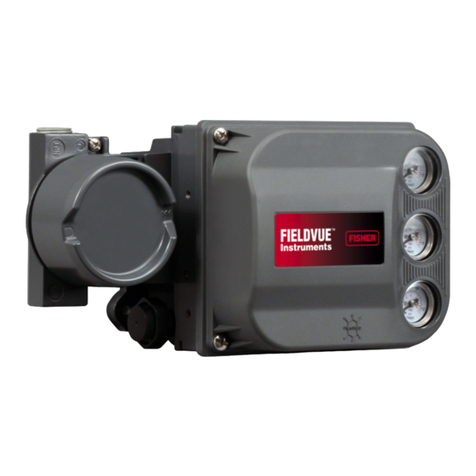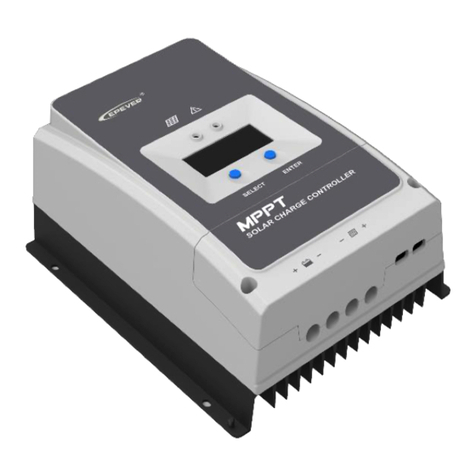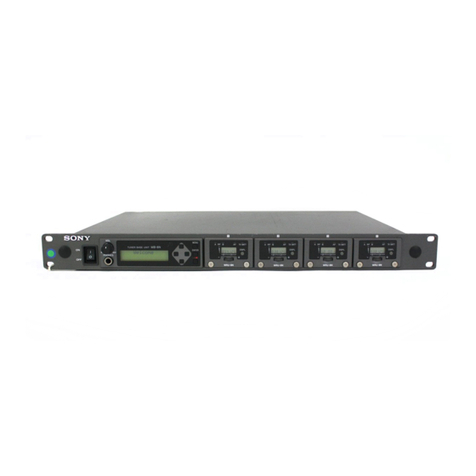Datakom DKG-329 User manual

DKG-329 User Manual V-12 (09.10.2012)
DKG-329 AUTOMATIC
TRANSFER SWITCH
CONTROLLER
WITH UNINTERRUPTED TRANSFER AND MULTIPLE GENSET SUPPORT
The DKG-329 is microprocessor controlled unit
designed to monitor 3-phase mains voltages, send
remote start command to generating sets and
control the changeover of generator and mains
contactors.
The unit offers an internal synchroscope for
uninterrupted transfer in both directions. The
number of gensets to run before transfer is
selectable, allowing multiple genset support.
If a fault condition occurs, the unit disables the
remote starting automaticallyand indicates the
failure with the corresponding led lamp and text.
The unit provides a comprehensive set of digitally
adjustable program parameters. The unauthorized
access to program parameters is prevented by a 3
level password system. All programs may be
modified via front panel pushbuttons and do not
require any external unit.
Last 100 faults are stored in the event log file. The
event log includes not only the date-time
information, but also a comprehensive list of
measured parameters at the time that the fault has
occurred.
The WINDOWS based RAINBOW program
allows remote monitoring and control.
The unit supports MODBUS protocol enabling
communication with PLCs and building
management systems. The MODBUS protocol is
also supported through GSM and PSTN
modems.
True RMS measurements
Synchroscope & check synch
No break transfer& no break load test
Automatic contactor control
Multiple genset system support
Load shedding, dummy load
Event logging with time stamp and measurements
Battery backed-up real time clock
Built in daily / weekly / monthly exerciser
Weekly operation schedule programs
Field adjustable parameters
RS-232 serial port
Free MS-Windows Remote monitoring SW
GSM and PSTN modem support
GSM SMS message sending on fault
MODBUS communications
Multiple language support
Customer logo display capability
16 Amp contactor outputs
1 Amp DC semiconductor control outputs
Configurable digital inputs: 7
Configurable digital outputs: 3
Total digital outputs: 6
I/O expansion capability
Plug-in connection system
Sealed front panel
FEATURES
DESCRIPTION

DKG-329 User Manual V-12 (09.10.2012)
- 2 -
Section
1. INSTALLATION
1.1. Introduction to the Control Panel
1.2. Mounting the Unit
1.3. Wiring the Unit
2. INPUTS AND OUTPUTS
3. DISPLAYS
3.1. Led Displays
3.2. Language Selection
3.3. Digital Display
4. ALARMS AND WARNINGS
5. MODES OF OPERATION
6. LOAD TRANSFER MODES
6.1. Transfer with Interruption
6.2. No Break Transfer
7.OTHER FEATURES
7.1. Remote start operation
7.2. Mains Simulation (Disable Start)
7.3. Delayed Mains Simulation, Battery Charging
7.4. Service Request Display
7.5. Engine Hours Meter
7.6. Date-Time Display
7.7. Display of Software Version
7.8. Modem connection
7.9. SMS message sending
7.10. Remote Monitoring and Programming
7.11. External Control of the Unit
7.12. Automatic Exerciser
7.13. Resuming to factory set parameters
7.14. Load Shedding / Dummy Load
7.15. Firmware Update
7.16. Pre-Transfer Signal
8. MODBUS COMMUNICATION
9. WEEKLY OPERATION SCHEDULE
10. EVENT LOGGING
11. STATISTICAL COUNTERS
12. MAINTENANCE
13. PROGRAMMING
14. TROUBLESHOOTING
15. DECLARATION OF CONFORMITY
16. TECHNICAL SPECIFICATIONS
17. CONNECTION DIAGRAM
TABLE OF CONTENTS

DKG-329 User Manual V-12 (09.10.2012)
- 3 -
The unit is a control and protection panel designed to monitor the 3-phase mains voltages, send remote
start command to the generating set and make changeover of both generator and mains contactors. The genset is
supposed to be controlled by a Remote Start type control unit. It shows the measured values on its display. The
unit is designed to provide user friendliness for both the installer and the user. Programming is usually
unnecessary, as the factory settings have been carefully selected to fit most applications. However
programmable parameters allow the complete control over the load transfer. Programmed parameters are
stored in a Non Volatile Memory and thus all information is retained even in the event of complete loss of
power.
Measured parameters are:
Mains voltage phase L1 to neutral
Mains voltage phase L2 to neutral
Mains voltage phase L3 to neutral
Mains voltage phase L1-L2
Mains voltage phase L2-L3
Mains voltage phase L3-L1
Mains frequency
Battery voltage
Gen voltage phase L1 to neutral
Gen voltage phase L2 to neutral
Gen voltage phase L3 to neutral
Gen voltage phase L1-L2
Gen voltage phase L2-L3
Gen voltage phase L3-L1
Load current phase L1
Load current phase L2
Load current phase L3
Gen frequency
Load total kW
Load total cos
Load L1 kW
Load L2 kW
Load L3 kW
Load L1 kVAr
Load L2 kVAr
Load L3 kVAr
Load L1 cos
Load L2 cos
Load L3 cos
Synchroscope phase angle
The unit is designed for panel mounting. The user should not be able to access parts of the unit
other than the front panel.
Mount the unit on a flat, vertical surface. Before mounting, remove the mounting brackets and
connectors from the unit, then pass the unit through the mounting opening. The unit will be maintained in its
position by the mounting brackets spring.
The output of the current transformers shall be 5 Amperes. The input current rating of the current
transformers maybe selected as needed (between 10/5 and 9000/5 amps). Current transformer outputs
shall be connected by separate cable pairs from each transformer, to related inputs. Never use common
terminals or grounding. The power rating of the transformer should be at least 5 VA. It is recommended to
use 1% precision transformers.
Programmable digital inputs are compatible with both ‘normally open’ and ‘normally closed’
contacts, switching either to BAT- or BAT+.
Engine body must be grounded for correct operation
of the unit, otherwise incorrect voltage and
frequency measurements may occur.
1.2 Mounting the Unit
1.1 Introduction to the Control Panel
1. INSTALLATION

DKG-329 User Manual V-12 (09.10.2012)
- 4 -
WARNING: ELECTRICITY CAN KILL
ALWAYS disconnect the power BEFORE
connecting the unit.The fuse rating should be 6
Amps.
1) ALWAYS remove the plug connectors when inserting wires with
a screwdriver.
2) An appropriate and readily accessible set of disconnection
devices (e.g. automatic fuses) MUST be provided as part of the
installation.
3) The building mains supply MUST incorporate appropriate short-
circuit backup protection (e.g. a fuse or circuit breaker) of High
Breaking Capacity (HBC, at least 1500A).
Use cables of adequate current carrying capacity (at least
0.75mm2) and temperature range.
WARNING: THE UNIT IS NOT FUSED.
Use external fuses for Mains phases: L1,L2,L3,
Generator phase: L1,L2,L3, Battery positive: BAT(+).
Install the fuses as nearly as possible to the unit in a
place easily accessible for the user.
1.3 Wiring the Unit

DKG-329 User Manual V-12 (09.10.2012)
- 5 -
RS-232 SERIAL PORT: This connector provides serial data input and output for various purposes like
remote monitoring and remote programming.
EXTENSION CONNECTOR: This connector is intended for the connection to output extension modules.
The optional relayextension module provides 8 programmable 16A relay outputs. The unit allows the use of
up to 2 I/O extension modules.
Term
Function
Technical data
Description
1
GENERATOR CONTACTOR
Relay output, 16A-AC
This output provides energy to the generator
contactor. If the generator phases do not have
acceptable voltage or frequency values, the
generator contactor will be de-energized. In
order to provide extra security, the normally
closed contact of the mains contactor should
be seriallyconnected to this output.
2
GEN-L1
Generator phase
inputs, 0-300V-AC
Connect the generator phases to these inputs.
The generator phase voltages upper and
lower limits are programmable.
3
GEN-L2
4
GEN-L3
5
GENERATOR NEUTRAL
Input, 0-300V-AC
Neutral terminal for the generator phases.
6
MAINS NEUTRAL
Input, 0-300V-AC
Neutral terminal for the mains phases.
7
MAINS-L3
Mains phase inputs,
0-300V-AC
Connect the mains phases to these inputs.
The mains voltages upper and lower limits are
programmable.
8
MAINS-L2
9
MAINS-L1
10
MAINS CONTACTOR
Relay output, 16A-AC
This output provides energy to the mains
contactor. If the mains phases do not have
acceptable voltages, the mains contactor will
be de-energized. In order to provide extra
security, the normally closed contact of the
generator contactor should be serially
connected to this output.
11
GROUND
O VDC
Power supply negative connection.
12
BATTERY POSITIVE
+12 or 24VDC
The positive terminal of the DC Supply shall
be connected to this terminal. The unit
operates on both 12V and 24V battery
systems.
13
NC
14
NC
15
NC
16
NC
2. INPUTS AND OUTPUTS

DKG-329 User Manual V-12 (09.10.2012)
- 6 -
Term
Function
Technical data
Description
17
RELAY-1
Output 1A/28VDC
This relay has programmable function,
selectable from a list.
18
RELAY-2
Output 1A/28VDC
This relay has programmable function,
selectable from a list.
19
HORN RELAY OUTPUT
Output 1A/28VDC
This relay controls the horn
20
REMOTE START OUTPUT
Output 1A/28VDC
This relay is used for remote start signal.
21
DIGITAL INPUT - 1:
EMERGENCY STOP
Digital inputs
These inputs have programmable
characteristics selected via the program
menu. Each input may be driven by a
‘normally closed’ or ‘normally open’ contact,
switching either battery+ or battery-. The effect
of the switch is also selectable from a list. See
PROGRAMMING section for more details.
22
DIGITAL INPUT - 2:
SPARE-1
23
PROGRAM LOCK
24
DIGITAL INPUT - 3:
SPARE-2
25
DIGITAL INPUT - 4:
SPARE-3
26
DIGITAL INPUT - 5:
FAULT RESET
27
DIGITAL INPUT - 6:
ALARM MUTE
28
DIGITAL INPUT - 7:
PANEL LOCK
29
CURR_1+
Current transformer
inputs, 5A-AC
Connect the load current transformer
terminals to these inputs. Do not connect the
same current transformer to other instruments
otherwise a unit fault will occur. Connect each
terminal of the transformer to the unit’s related
terminal. Do not use common terminals. Do
not use grounding. Correct polarity of
connection is vital. If the measured power is
negative, then change the polarity of each 3
current transformers. The rating of the
transformers should be the same for each of
the 3 phases. The secondary winding rating
shall be 5 Amperes. (For ex. 200/5 Amps).
30
CURR_1-
31
CURR_2+
32
CURR_2-
33
CURR_3+
34
CURR_3-

DKG-329 User Manual V-12 (09.10.2012)
- 7 -
The unit has 12 LEDs, divided in 3 groups:
-Group_1: Operating mode: This group indicates the genset function.
-Group_2: Mimic diagram: This group indicates the current status of the mains and genset
voltages and contactors.
-Group_3: Warnings and alarms: This group indicates the existence of abnormal conditions
encountered during operation.
Function
Color
Description
MAINS ON
Green
The LED will turn on when all 3 mains phase voltages
are within the limits.
MAINS OFF
Red
The LED will turn on when at least one of the mains
phase voltages is outside limits.
LOAD MAINS
Green
It turns on when the mains contactor is activated.
LOAD GENERATOR
Yellow
It turns on when the generator contactor is activated.
GENERATOR
Yellow
The LED will flash when the engine is running. It will
turn on steadily when all 3 generator phase voltages
are within the programmed limits.
LOAD TEST
Yellow
It turns on when the related operation mode is
selected. One of these LEDs is always on and
indicates which operation mode is selected.
If the operation of the genset is disabled by the
weekly operation schedule, then the AUTO led will
flash.
TEST
Yellow
OFF
Yellow
AUTO
Green
ALARM
Red
If a fault condition resulting to the engine shutdown
has occurred, the alarm led turns on steadily. If a
loaddump condition occurs, this led will flash. Alarms
work on a first occurring basis. The occurrence of a
fault will disable other faults of lower or equal priority.
WARNING
Red
If a warning condition has occurred, this led turns on
steadily. The warnings work on a first occurring basis.
The occurrence of a warning will disable other
warnings, however shutdown and loaddump alarms
are still allowed.
SERVICE REQUEST
Red
Engine periodic maintenance request indicator. It
turns on when the preset engine hours or time
duration after previous service has elapsed.
3.1 Led Displays
3. DISPLAYS

DKG-329 User Manual V-12 (09.10.2012)
- 8 -
The unit is able to display information in 3 languages. Language selection is made through program
parameter CONTROLLER CONFIGURATION > LANGUAGE SELECTION. Below selections are available:
0: English language
1: Turkish language
2: Chinese language
3: ask selection at power-up
If language is set to 3, below screen will come at power on:
Left / Up / Down arrow pushbuttons will select the screen language. The language will be asked
everytime power is turned on.
With selections of 0,1,2 this screen will not appear and the selected language is enabled.
The unit has a graphical 128x64 pixel LCD display. It shows:
-Measured parameters,
-The company logo,
-The alarm list
-Software version and date-time information,
-Statistical counters,
-Event records,
-Program parameters.
Navigation between different screens s made with the ◄MENU and MENU►buttons. Each
depression of the MENU►button switches the display to the next screen. Each depression of the
◄MENU button switches the display to the previous screen.
During operation, the unit will switch automatically between different screens, displaying always
the most important parameters for the current operating status.
If an alarm or warning occurs during operation, in other then programming mode, the display will
automatically switch to ALARM LIST position. The ◄MENU or MENU►buttons will not function. To
enable display navigation and mute the internal buzzer, press ALARM MUTE button first. If there is
more than one alarm, the next alarm is displayed by pressing the ▼ button. Thus all existing alarms can
be scanned. ‘END OF ALARM LIST’ will be displayed when there is no more alarm to display.
The display has a backlight illumination feature. The backlight turns on with the depression of
any button or when the genset runs. It turns off after 4 hours to allow power economy.
3.3 Digital Display
3.2 Language Selection

DKG-329 User Manual V-12 (09.10.2012)
- 9 -
Screen
Description
Contents
1
Mains parameters
(phase to neutral)
Genset status
Mains Volts L1, Mains Frequency
Mains Volts L2 , Battery Voltage
Mains Volts L3,
2
Mains parameters
(phase to phase)
Genset status
Mains Volts L1-L2, Mains Frequency
Mains Volts L2-L3, Battery Voltage
Mains Volts L3-L1,
3
Genset parameters
(phase to neutral)
Genset status
Genset Volts L1, Genset Frequency
Genset Volts L2, Battery Voltage
Genset Volts L3,
4
Genset parameters
(phase to phase)
Genset status
Genset Volts L1-L2, Genset Frequency
Genset Volts L2-L3, Battery Voltage
Genset Volts L3-L1,
5
Load parameters
(currents)
Genset status
Load Current L1, Load Frequency
Load Current L2, Load Active Power (kW)
Load Current L3, Load Power Factor
6
Load Phase Power
parameters
Genset status
Genset Phase L1 : Active Power(kW) / Power Factor
Genset Phase L2 : Active Power(kW) / Power Factor
Genset Phase L3 : Active Power(kW) / Power Factor
7
Load Phase Power
parameters
Genset status
Genset Phase L1 : Reactive Power(kVAr)
Genset Phase L2 : Reactive Power(kVAr)
Genset Phase L3 : Reactive Power(kVAr)
8
Synchroscope
Phase Angle
Voltage difference mains_L1 –gen_L1
Frequency difference mains-gen
Angle difference mains-gen
9
Company Logo
10
Alarm List
If no alarm exists, ‘END OF ALARM LIST’ will be displayed.
Existing alarms, load_dumps and warnings will be displayed
as one screen for each entry. Switching to the next entry will
be made with the ▼ button.
11
Date-Time,
Software Version
Date and time.
Operating software version.
12
Statistical Counters 1 / 2
Engine Hours Run
Total Genset Active Power (kW-h)
13
Statistical Counters 2/ 2
Engine Hours to Service
Time to Service
14
Event Records
The unit provides information about last 100 events, starting
from the most recent one.
Please review chapter 10 for detailed information about event
logging.

DKG-329 User Manual V-12 (09.10.2012)
- 10 -
Alarms indicate an abnormal situation in the generating set are divided into 3 priority levels:
1- ALARMS: These are the most important fault conditions and cause:
-The ALARM led to be on steadily,
-The genset contactor to be released immediately,
-The engine to be stopped immediately,
-The Horn, Alarm,Alarm+Load_dump and Alarm+Load_dump+Warning digital
outputs to operate, (if selected via programming menu)
2- LOAD_DUMPS: These fault conditions cause:
-The ALARM led to flash,
-The genset contactor to be released immediately,
-The engine to be stopped after Cooldown period,
-The Horn, Alarm+Load_dump and Alarm+Load_dump+Warning digital outputs to
operate, (if selected via programming menu)
3- WARNINGS: These conditions cause:
-TheWARNING led to be on steadily,
-The Horn and Alarm+Load_dump+Warning digital outputs to operate, (if selected
via programming menu)
If the ALARM MUTE button is pressed, the Horn output will be deactivated; however the
existing alarms will persist and disable the operation of the genset.
Alarms operate in a first occurring basis:
-If an alarm is present, following alarms, load_dumps and warnings will not be accepted,
-If a load_dump is present, following load_dumps and warnings will not be accepted,
-If a warning is present, following warnings will not be accepted.
Alarms maybe of LATCHING type following programming. For latching alarms, even if the alarm
condition is removed, the alarms will stay on and disable the operation of the genset. The existing alarms
may be canceled by pressing one of the operating mode buttons (LOAD TEST / TEST / OFF / AUTO).
Most of the alarms have programmable trip levels. See the programming chapter for adjustable
alarm limits.
EMERGENCY STOP: Set if a signal is detected at the emergency stop input.
SPARE-1 / SPARE-2: Set if a signal is detected from the related spare fault input.
MAINS CB FAIL TO CLOSE (warning): Set if the mains contactor feed back input is not active at the end
of mains contactor timeout when mains contactor is activated. Enabled if one of digital inputs assigned as
mains contactor feed back input.
MAINS CB FAIL TO OPEN (load_dump): Set if the mains contactor feed back input is still active at the
end of mains contactor timeout when mains contactor is deactivated. Enabled if one of digital inputs
assigned as mains contactor feed back input.
GENSET CB FAIL TO CLOSE (warning): Set if the genset contactor feed back input is not active at the
end of genset contactor timeout when genset contactor is activated. Enabled if one of digital inputs
assigned as genset contactor feed back input.
GENSET CB FAIL TO OPEN (warning): Set if the genset contactor feed back input is still active at the
end of genset contactor timeout when genset contactor is deactivated. Enabled if one of digital inputs
assigned as genset contactor feed back input. The mains contactor cannot operate when this warning is
up.
LOW SPEED / HIGH SPEED: Set if the generator frequency is outside programmed limits. These faults
will be monitored with Holdoff Timer delay after the engine is running. Low and high limits for warning and
alarm are separately programmable. Another high frequency shutdown limit which is 12% above the high
limit is always monitored and stops the engine immediately.
4. ALARMS AND WARNINGS

DKG-329 User Manual V-12 (09.10.2012)
- 11 -
STOP FAIL (warning): Set if the engine has not stopped before the expiration of the Stop Timer.
OVERLOAD (load_dump): Set if at least one of the genset phase currents goes over the Overcurrent
Limit for Overload Timer. If currents goes below the limit before expiration of the timer then no alarm will
be set.
EXCESS POWER (load_dump): Set if the genset power (kW) supplied to the load goes over the Excess
Power limit for Overload Timer. If the power goes below the limit before expiration of the timer then no
alarm will be set.
GENSET LOW VOLTAGE: Set if any of the generator phase voltages goes outside programmed limits for
Overload Timer. This fault will be monitored with holdoff timer delay after the engine is running.
GENSET HIGH VOLTAGE: Set if any of the generator phase voltages goes outside programmed limits for
Overload Timer. This fault will be monitored with holdoff timer delay after the engine is running.
LOW BATTERY VOLTAGE (warning): Set if the battery voltage goes below the programmed limit.
HIGH BATTERY VOLTAGE: Set if the battery voltage goes above programmed limits. Both warning and
alarm levels for high battery voltage are programmable.
MAINS PHASE ORDER FAIL (warning): Set if the mains phase order checking is enabled, mains phases
are present and mains phase order is reversed. This fault prevents the Mains Contactor to close.
The modes of operation are selected by pushing the front panel keys. Changing the operation
mode while the genset is running will result to a behavior suitable for the new operating mode. For example,
if the LOAD TEST mode is selected when genset is running at TEST mode, then the load will be transferred
to the genset.
OFF: In this mode, the mains contactor will be energized if mains phase voltages are within the
programmed limits. The engine will be stopped.
AUTO: It is used for genset and mains automatic transfer. If at least one of the mains phase voltages is
outside limits, the mains contactor will be deactivated and the REMOTE START output will be activated at
the end of the start wait period. The engine will run without load during engine heating period. After this, if
alternator phase voltages and frequency are within limits, then the unit will wait for the generator contactor
period and the generator contactor will be energized.
When all the mains phase voltages are within the limits, the engine will continue to run for the mains waiting
period. At the end of this period the generator contactor is deactivated and the mains contactor will be
energized. If a cooling period is given, the REMOTE START output will be active during the cooling period.
At the end of the period, the REMOTE START output will be de-energized and the diesel will stop. The unit
will be ready for the next mains failure. If the operation of the genset is disabled by the weekly schedule,
then the AUTO led will flash, and the operation of the genset will be as in the OFF mode.
TEST: It is used to test the generator when the mains are on, or keep the generator running in the
emergency backup mode. The operation of the generator is similar to the AUTO mode, but the mains
contactor will not be deactivated if the mains are not off. If the mains are off, mains contactor will be
deactivated and the generator contactor will be activated. When the mains are on again, a changeover to
the mains will be made, but the engine will be kept running unless another mode is selected. To stop the
engine, select AUTO or OFF mode.
LOAD TEST: It is used to test the genset under load. Once this mode is selected, the engine will run and
the load will be transferred to the genset. The genset will feed the load indefinitely unless another mode is
selected.
5. MODES OF OPERATION

DKG-329 User Manual V-12 (09.10.2012)
- 12 -
The unit has two ways of transferring the load from genset to mains and vice versa.
These modes are:
-transfer with interruption.
-no break transfer.
This is the most conventional way of transferring the load between the genset and mains. There
will be a power interruption period duration during the transfer. Note that the program parameters Mains
Contactor Timer and Genset Contactor Timer define the power interruption period.
Transfer from genset to mains:
-The generator contactor releases,
-The unit waits for Mains Contactor Timer
-The mains contactor is energized.
Transfer from mains to genset:
-The mains contactor releases,
-The unit waits for Genset Contactor Timer
-The generator contactor is energized.
In this mode, the transfer will be made without power interruption. This implies that both of
the mains and generator contactors will be active during transfer.
The maximum duration that both contactors will be activated is programmable. However this
process may be quicker with the use of one auxiliary contact at each contactor. Thus the changeover
will be quite instantaneous, preventing any excess or reverse power condition. Any digital input can be
programmed for genset contactor auxiliary contact and mains contactor auxiliary contact.
To prevent a phase to phase short circuit below criteria must be met:
-The mains and generator voltages must be equal,
-The mains and generator voltages must have the same phase,
-The mains and generator voltages must have the same phase sequence order.
The unit will allow a No Break Transfer only if all of the below conditions are fulfilled:
-Mains phase voltages within the programmed limits,
-Mains frequency within the programmed limits,
-Genset phase voltages within the programmed limits,
-Genset frequency within the programmed limits,
-Mains phase order correct (or phase order check must be disabled),
-Genset phase order correct (or phase order check must be disabled),
-The difference between mains and genset frequencies not more than programmed limit,
-The voltage difference between mains_L1 and genset_L1 not more than programmed limit,
-The phase angle between mains_L1 and genset_L1 not more than programmed limit,
If this transfer method is used, it is advised to make an electrical
interlock between contactors to prevent a phase to phase short
circuit.
6.1 No Break Transfer
6.1 Transfer with Interruption
6. LOAD TRANSFER MODES

DKG-329 User Manual V-12 (09.10.2012)
- 13 -
When a No Break Transfer cycle is initiated, the unit checks all the above criteria to be
satisfied as long as the Synchronization Fail Timeout is not expired.
Normally with frequencies matching at +/- 2Hz and voltages matching at +/-10 volts an
uncontrolled No Break Transfer will be successfull.
If synchronization conditions are not met at the expiration of the Synchronization Fail
Timeout, then the unit reverts to a Transfer with Interruption.
If matching is found before the expiration of the Synchronization Fail Timeout, then both
contactors will be activated. If contactor auxiliary contacts are used, the other contactor will release
immediately. If contactor auxiliary contacts are not used, the other contactor will release after contactor
timeout.
The unit has a set of programmable parameters to define the No Break Transfer operation.
These parameters are:
Mains Voltage Low Limit (Electrical Parameters): Each of the mains phase voltages must be over
this limit.
Mains Voltage High Limit (Electrical Parameters): Each of the mains phase voltages must be below
this limit.
Mains Frequency Low Limit (Electrical Parameters): The mains frequency must be over this limit.
Mains Frequency High Limit (Electrical Parameters): The mains frequency must be below this limit.
Genset Voltage Low Limit (Electrical Parameters): Each of the genset phase voltages must be over
this limit.
Genset Voltage High Limit (Electrical Parameters): Each of the genset phase voltages must be
below this limit.
Low Frequency Shutdown (Engine Parameters): The genset frequency must be over this limit.
Low Frequency Warning (Engine Parameters): The genset frequency must be over this limit.
High Frequency Shutdown (Engine Parameters): The genset frequency must be below this limit.
High Frequency Warning (Engine Parameters): The genset frequency must be below this limit.
Genset Phase Order Enable(Electrical Parameters): If set , this parameter will enable the phase
order check for genset. The phase order check should be disabled only in single phase gensets.
Mains Phase Order Enable(Electrical Parameters): If set, this parameter will enable the phase order
check for mains.
No Break Transfer(Controller Config Parameters): This parameter enables/disables the No Break
Transfer feature.
Max Frequency Difference(Controller Config Parameters): This is the maximum difference between
mains and genset frequencies to enable a NO Break Transfer.
Max Voltage Difference(Controller Config Parameters): This is the maximum difference between the
mains_L1 and genset_L1 voltages to enable a NO Break Transfer.
Max Phase Difference(Controller Config Parameters): This is the maximum phase difference
between the mains_L1 and genset_L1 to enable a No Break Transfer.
Synchronization Fail Timeout (Controller Config Parameters): If the phase and voltage
synchronization is not successful before the expiration of this timer, then the unit terminates the No
Break Transfer and makes a Transfer with Interruption.
Contactor Timeout (Controller Config Parameters): This is the maximum time duration in which both
contactors are active in case of No Break Transfer.
Any digital input may be assigned as mains and genset contactor feedback input for faster transfer.
For this, “digital input function select parameter group”is used to select the function and “input
configuration parameter group”is used to configure digital inputs. The action parameter should be
set to 3and “always active” option should be selected for both contactor feedback inputs. NC type
must be selected for mains contactor feedback input.(Pls refer to programming chapter for more
detailed explanation)

DKG-329 User Manual V-12 (09.10.2012)
- 14 -
The unit offers the possibility of REMOTE START mode of operation. Any digital input may be
assigned as Remote Start Input using Input Function Select program parameters.
The REMOTE START signal may be a NO or NC contact, switching to either battery positive or
batterynegative. These selections are made using programming menu.
It is also necessary to set the ACTION program parameter of the related input to 3in order to
prevent any alarm from this input.
In this mode the mains phases are not monitored. If the REMOTE START signal is present then
the mains will be supposed to fail, inversely if the REMOTE START signal is absent, then mains
voltages will be supposed to be present. The front panels mimic diagram’s mains LEDs will reflect the
status of the REMOTE START input.
The unit offers an optional SIMULATE MAINS signal input. Any digital input may be assigned
as Simulate Mains using Input Function Select program parameters.
It is also necessary to set the ACTION program parameter of the related input to 3in order to
prevent any alarms generated from this input.
The SIMULATE MAINS signal may be a NO or NC contact, switching to either battery positive or
batterynegative. These selections are made using the programming menu.
If the Simulate Mains input is defined and the input signal is active, the mains phases are not
monitored and supposed to be inside limits. This will prevent the genset from starting even in case of a
mains failure. If the genset is running when the signal is applied, then usual Mains Waiting and
Cooldown cycles will be performed before engine stop. When the SIMULATE MAINS signal is present,
the front panels mimic diagram’s mains LEDs will reflect the mains voltages as present.
When the signal is passive, the unit will revert to normal operation and monitor the mains
voltage status.
The REMOTE START operation overrides SIMULATE MAINS and
FORCE TO START operations.
7.2 Mains Simulation (Disable Start)
7.1 Remote Start Operation
7. OTHER FEATURES

DKG-329 User Manual V-12 (09.10.2012)
- 15 -
The Delayed Mains Simulation feature is used in battery backed up telecom systems where
batteries are able to supply the load during a certain period. The genset is requested to run only when
battery voltage drops below the critical level. Once the engine runs, the rectifier system starts charging
the batteries and the battery voltage goes up immediately. Thus the engine should continue to run a
programmed period for effective charging. The critical battery voltage level will be detected by an
external unit which provides the digital Simulate Mains signal for the genset control unit.
The unit offers an optional SIMULATE MAINS signal input. Any digital input may be assigned
as Simulate Mains using Input Function Select program parameters.
It is also necessary to set the ACTION program parameter of the related input to 3in order to
prevent any alarms generated from this input.
The SIMULATE MAINS signal may be a NO or NC contact, switching to either battery positive or
batterynegative. These selections are made using the programming menu.
If the Delayed Simulate Mains program parameter is set to 1 and the input signal is active
when the genset is not feeding the load, the mains phases are not monitored and supposed to be inside
limits. This will prevent the genset from starting when the simulate mains signal is present (batteries
charged). The genset will start when mains voltages are out of limits and the simulate mains signal not
present.
If the genset is running when the signal is applied, then MAINS SIMULATION will be prevented
during Flashing Relay Timer program parameter. After this, usual Mains Waiting and Cooldown cycles
will be performed before engine stop. When the SIMULATE MAINS signal is present, the front panels
mimic diagram’s mains LEDs will reflect the mains voltages as present.
When the signal is passive, the unit will revert to normal operation and monitor the mains
voltage status.
The REMOTE START operation overrides DELAYED SIMULATE
MAINS operation. When both parameters “Remote Start
Operation” and “Delayed Simulate Mains” are set then REMOTE
START operation mode is performed.
The REMOTE START operation overrides SIMULATE MAINS and
FORCE TO START operations.
7.3 Delayed Mains Simulation, Battery Charging

DKG-329 User Manual V-12 (09.10.2012)
- 16 -
This led is designed to help the periodic maintenance of the genset to be made consistently.
The periodic maintenance is basically carried out after a given engine hours (for example 200
hours), but even if this amount of engine hours is not fulfilled, it is performed after a given time limit (for
example 12 months).
The unit has both programmable engine hours and maintenance time limit. The engine hours is
programmable with 50-hour steps, the time limit is programmable with 1 month steps. If any of the
programmed values is zero, this means that the parameter will not be used. For example a maintenance
period of 0 months indicates that the unit will request maintenance only based on engine hours, there will
be no time limit. If the engine hours is also selected as 0 hours this will mean that the SERVICE REQUEST
display will be inoperative.
When the engine hours OR the time limit is over, the SERVICE REQUEST led (red) will start to
flash and the service request relayfunction will be active.
The service request relay function may be assigned to spare relays using Relay Definition
program parameters. Also relays on an extension module may be assigned to this function.
The remaining engine hours and the remaining time limit are kept stored in a non-volatile memory
and are not affected from power supply failures.
The time and engine hours to service are displayed in the STATISTICAL COUNTERS menu.
The unit features a non-erasable incremental engine hour meter. The hourmeter information is
kept in a non-volatile memoryand is not affected from power supply failures.
The engine hours maybe displayed STATISTICAL COUNTERS menu.
The date & time display is provided for verification.
To turn off the SERVICE REQUEST led, and reset the
service period, press together the ALARM MUTE and
LAMP TEST keys for 5 seconds.
The SERVICE REQUEST led has no effect on the genset
operation.
7.6 Date & Time Display
7.5 Engine Hour Meter
7.4 Service Request Display

DKG-329 User Manual V-12 (09.10.2012)
- 17 -
Some additional features are installed within consecutive software releases. In order to be sure
of the validity of the status of the unit, the software version needs to be known.
The software version of the unit is displayed together with the data –time information.
The software version consists of 2 numbers. The first number represent the operating software
version of the unit.
The unit is capable of making modem calls in case of alarm, as well as answering modem calls
made from a remote location. GSM modems and classic cable network (PSTN) modems are
acceptable.
If the modem is connected to the unit, the Modem Enable program parameter should be set to
1, otherwise faulty operation may occur.
A maximum of 2 telephone numbers can be defined for outgoing modem calls. In case of alarm,
the unit will attempt to reach control centers associated with each number. In case of modem
connection failure, the call will be repeated up to 30 times with 2 minute intervals.
When the modem call is in progress, a telephone icon ( ) will appear at the upper right
corner of the screen.
Advised modems are DATAKOM types which are powered up from the same DC battery
voltage than the unit. Most of other desktop modems with standard AT commands are also usable, but it
is the user’s responsibility to provide an uninterrupted AC supply source to the modem. The necessary
modem cable will be supplied by DATAKOM.
Modem calls are always terminated by the central RAINBOW software. However the unit does
not allow connection durations exceeding 2 minutes, and hangs up the modem when this period
expires.
The PC program used for remote monitoring and programming is the same RAINBOW software
used for RS-232 connection.
Please note that the modem operation is also compatible with the MODBUS communication.
Thus the unit can iniate and receive calls to/from a MODBUS master station. Please review chapter_8
for more details on MODBUS communication.
If Modem Enable or SMS Enable or MODBUS Address parameters
are different from zero, the local PC connection will not work.
7.8 Modem Connection
7.7 Software Version Display

DKG-329 User Manual V-12 (09.10.2012)
- 18 -
The GSM SMS sending is activated by setting the SMS Enable program parameter to 1.
When a fault condition occurs, the unit will compose an SMS message and will send it to up to 6
phone numbers. If modem is enabled, only 4 telephone numbers are available for SMS sending.
The unit is also able to send SMS messages in below conditions, without creating a visible alarm or
warning:
Mains Fail, Mains Restored (enabled via SMS on Mains Change program parameter)
If both modem and SMS are enabled, the unit will send SMS messages first and attempt modem
connection afterwards.
When SMS sending is in progress, an (SMS) icon will appear at the upper right corner of the
screen.
The maximum number of alarms transmitted in a SMS message is 4. This limitation is due to the
maximum length of an SMS message which is 160 characters.
A sample GSM SMS message is given below:
DKGxxx <SITE-ID>
STOP : EMERGENCY STOP.
END OF ALARM LIST
The first line of the message carries information about the unit type and the site identity string. This
line is intended for the identification of the genset sending the SMS message.
Each following line will give one fault information. The message will always be terminated by the
“END OF ALARM LIST” string.
When the message is sent, the existing alarms will be masked, causing the audible alarm relay to
release and preventing consecutive GSM SMS messages. Any new upcoming alarm will result in a new
GSM SMS message. The new message will indicate all existing alarms, even masked ones.
The necessary GSM modem cable will be supplied by DATAKOM. This is the same cable as
PSTN (land) modems.
If Modem Enable or SMS Enable or MODBUS Address parameters
are different from zero, the local PC connection will not work.
7.9 SMS Message Sending

DKG-329 User Manual V-12 (09.10.2012)
- 19 -
Thanks to its standard serial RS-232 port, the unit offers the remote monitoring and
programming feature.
The remote monitoring and programming PC software is called RAINBOW and may be
downloaded from www.datakom.com.tr internet site with password login.
The modem, SMS and Modbus modes are not compatible with the local PC connection. Modem
Enable, SMS Enable and MODBUS Address program parameters should be set to 0 before connection.
The RAINBOW software allows the visualization and recording of all measured parameters. The
recorded parameters may then be analyzed graphically and printed. The software also allows the
programming of the unit and the storage of the program parameters to PC or the downloading of stored
parameters from PC to the unit.
For PCs without a serial port, below USB to serial adapters are tested and approved :
DIGITUS USB 2.0 TO RS-232 ADAPTER (PRODUCT CODE: DA70146 REV 1.1)
DIGITUS USB 1.1 TO RS-232 ADAPTER (PRODUCT CODE: DA70145 REV 1.1)
FLEXY USB 1.1 TO SERIAL ADAPTER (PRODUCT CODE BF-810)
CASECOM USB TO SERIAL CONVERTER (MODEL: RS-01)
The necessary PC connection cable will be supplied by DATAKOM.
The unit offers total external control through programmable digital inputs. Each digital input may be
programmed for below external control functions:
- Force OFF mode
- Force AUTO mode
- Force TEST mode
- Force LOAD TEST mode
- Disable Auto Start
- Force to Start
- Fault Reset
- Alarm Mute
- Panel Lock
External mode select signals have priority on mode buttons of the unit. If the mode is selected by
external signal, it is impossible to change this mode with front panel keys. However if the external mode
select signal is removed, the unit will revert to the last selected mode via pushbuttons.
It is also possible to lock the front panel completelyfor remote command.
7.11 External Control of the Unit
7.10 Remote Monitoring and Programming

DKG-329 User Manual V-12 (09.10.2012)
- 20 -
The unit offers automatic exerciser operation. The exercise operation may be done on a daily,
weekly or monthly basis.
The start day and time of the exercise is programmable as well as its duration. The exercise
may be done with or without load following programming.
Program parameters related to the exerciser are:
Exercise start day and hour
Exercise duration
Exercise off_load/on_load
Exerciser Period (Daily / Weekly / Monthly)
Please refer to the programming section for a more detailed description of the above
parameters.
When the start day and hour of exercise has come, the unit will automatically switch to either
TEST or LOAD TEST mode. The engine will run and if the on_load exercise is selected then the load
will be transferred to the genset.
If a mains failure occurs during the off-load exercise, the load will not be transferred to the
genset unless the Emergency Backup Operation is allowed by setting the related program parameter
to 1. Thus it is highly recommended that the Emergency Backup mode enabled with off-load exerciser.
At the end of the exercise duration, the unit will switch back to the initial mode of operation.
If any of the mode selection keys are pressed during exercise, then the exercise will be
terminated.
Using the daily exercise mode, the unit may feed the load from the genset during predefined
hours of the day. This operation may be used in high tariff periods of the day.
In order to resume to the factory set parameter values:
-hold pressed the OFF, LAMP TEST and ALARM MUTE buttons for 5 seconds,
-“RETURN TO FACTORY SET” will be displayed
-immediately press and hold pressed the ALARM MUTE button for 5 seconds
-factory set values will be reprogrammed to the parameter memory.
It is not possible to restore user parameters.
7.13. Resuming to factory set parameters
7.12 Exerciser
Table of contents
Other Datakom Controllers manuals
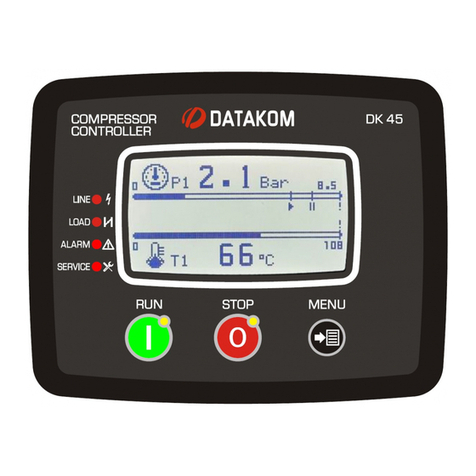
Datakom
Datakom DK-45 User manual
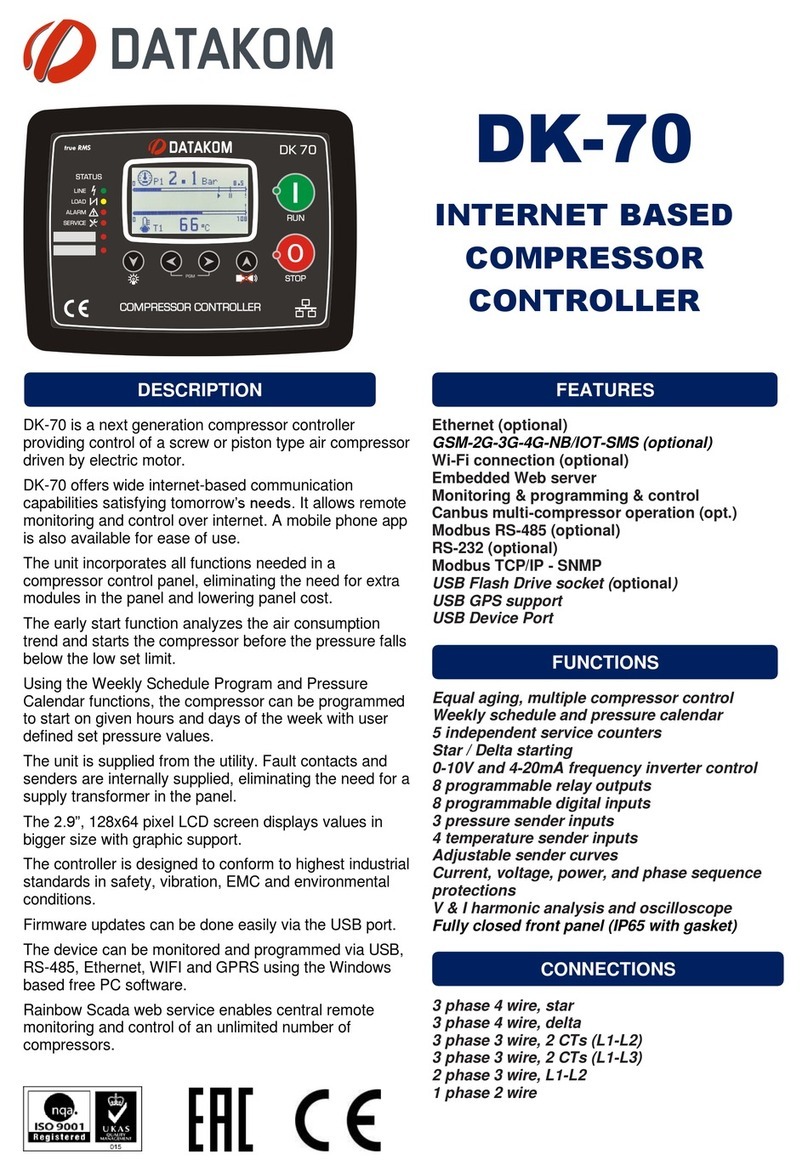
Datakom
Datakom DK-70 User manual
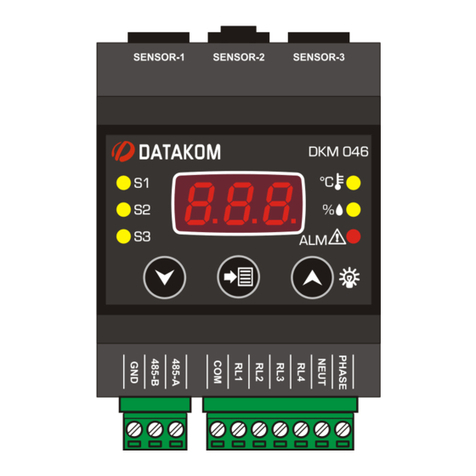
Datakom
Datakom DKM-046 User manual
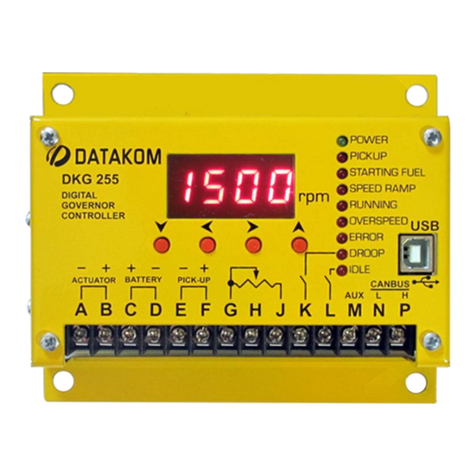
Datakom
Datakom DKG-255 User manual
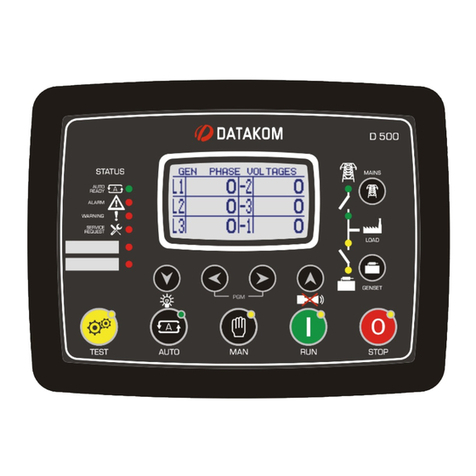
Datakom
Datakom D-500 User manual
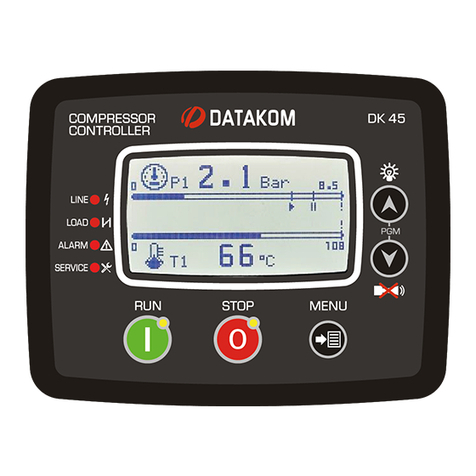
Datakom
Datakom DK-45 MK2 User manual
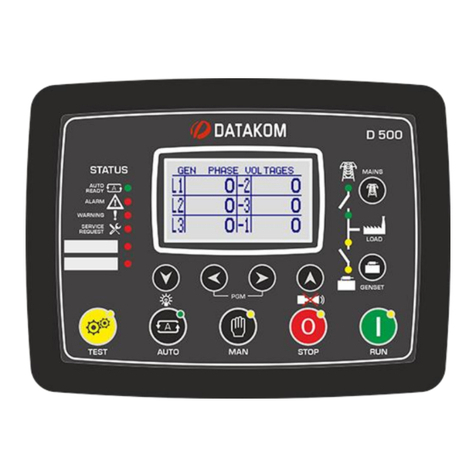
Datakom
Datakom D-500 MK3 User manual
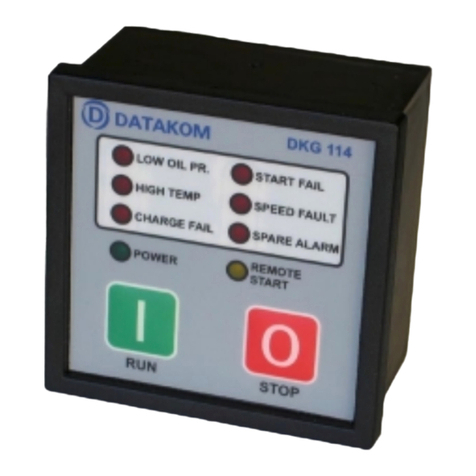
Datakom
Datakom DKG-114 Manual
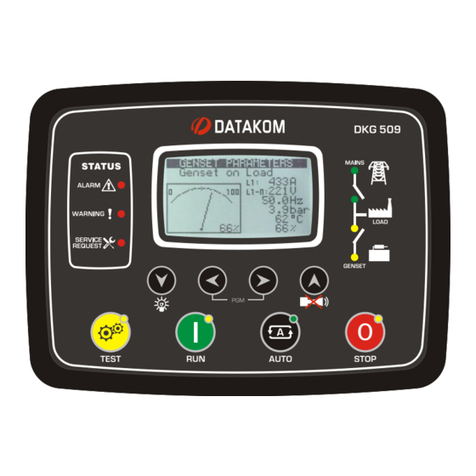
Datakom
Datakom DKG-509 User manual
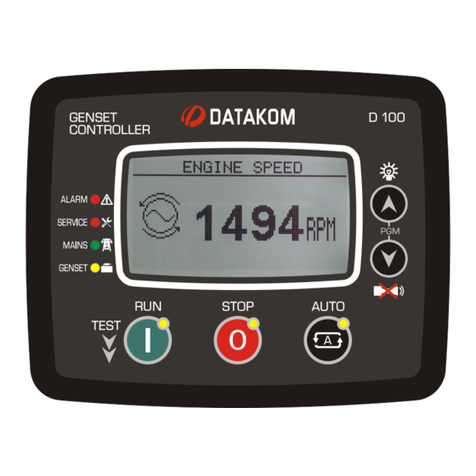
Datakom
Datakom D-100 MK2 User manual
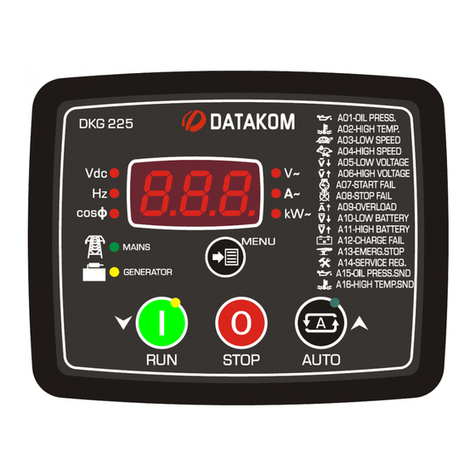
Datakom
Datakom DKG-225 User manual
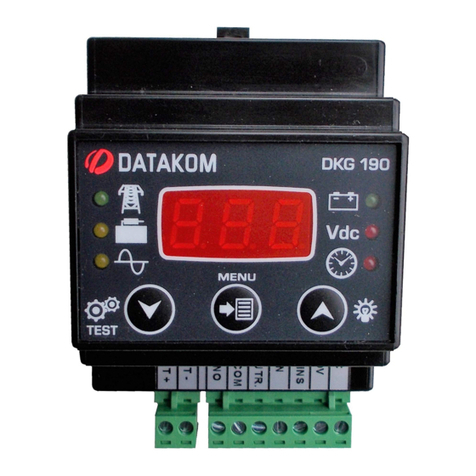
Datakom
Datakom DKG-190 User manual
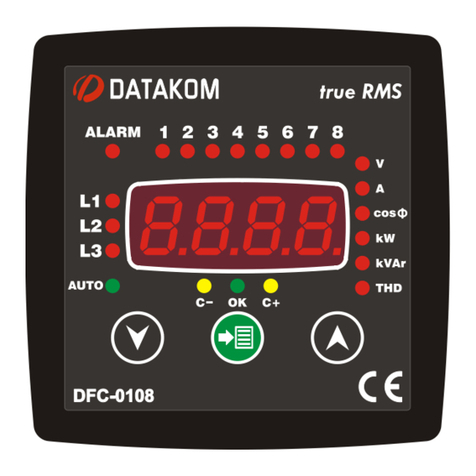
Datakom
Datakom DKG-108 User manual
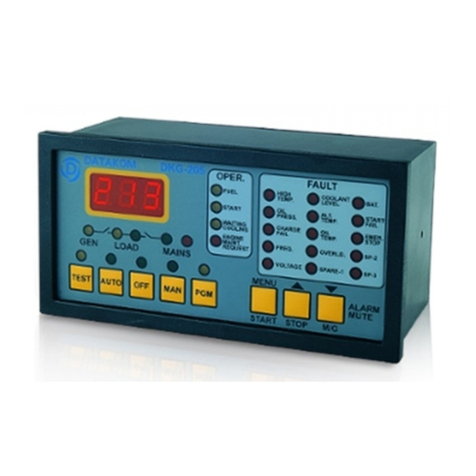
Datakom
Datakom DKG-205 User manual
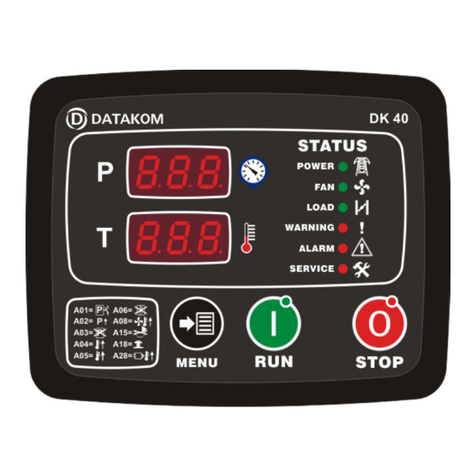
Datakom
Datakom DK-40 User manual
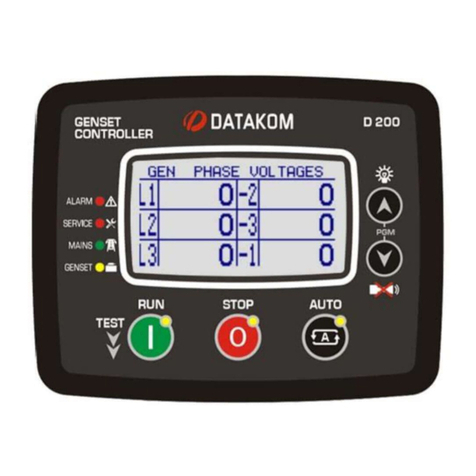
Datakom
Datakom D-200 MK2 User manual
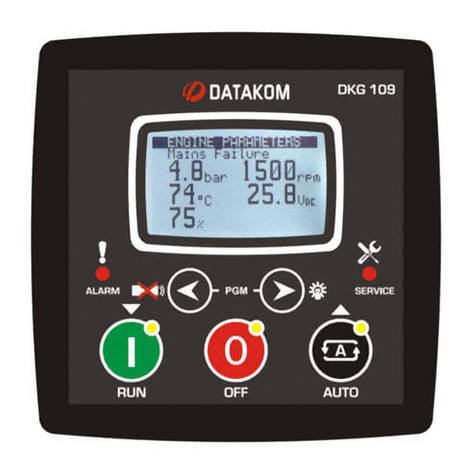
Datakom
Datakom DKG-109 User manual

Datakom
Datakom D-500 MK2 User manual
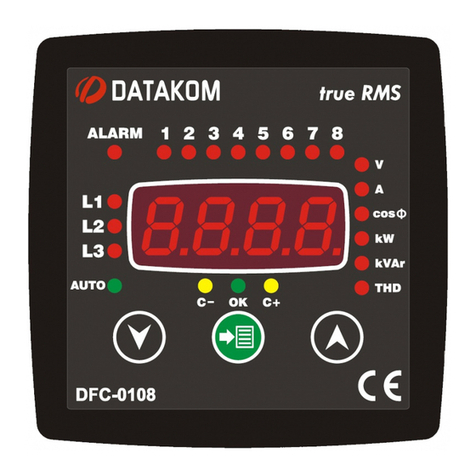
Datakom
Datakom DFC-0108 User manual
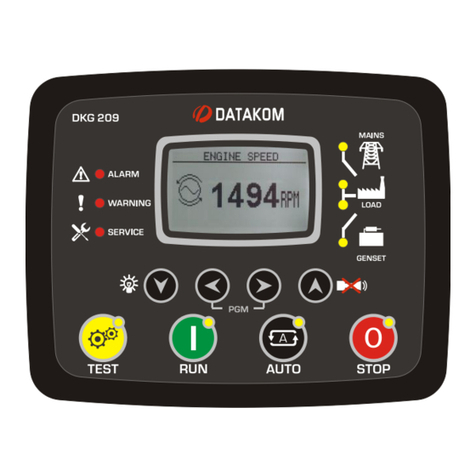
Datakom
Datakom DKG-209 User manual
